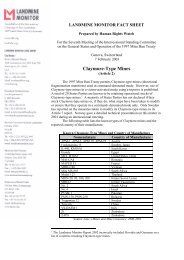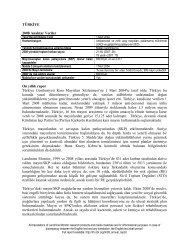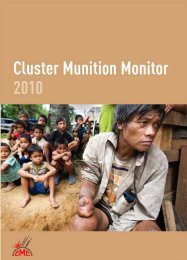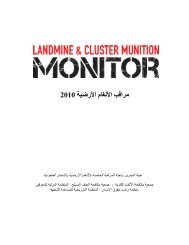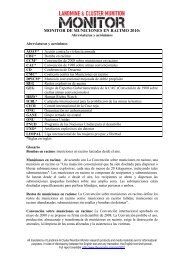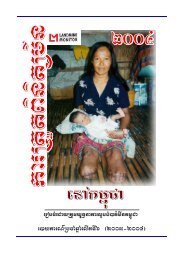Download PDF - Landmine and Cluster Munition Monitor
Download PDF - Landmine and Cluster Munition Monitor
Download PDF - Landmine and Cluster Munition Monitor
You also want an ePaper? Increase the reach of your titles
YUMPU automatically turns print PDFs into web optimized ePapers that Google loves.
<strong>Cluster</strong> <strong>Munition</strong> <strong>Monitor</strong> 2012<br />
areas, farml<strong>and</strong>, pasture, rivers <strong>and</strong> streams, on hillsides, in desert areas, in <strong>and</strong> around former military barracks,<br />
on roads, in minefields, <strong>and</strong> in ammunition storage areas. 53<br />
• Vietnam is contaminated as a result of an estimated 413,130 tons (4.1 million kg) of submunitions used by<br />
the US in 1965–1973. 54 <strong>Cluster</strong> munitions were used in 55 provinces <strong>and</strong> cities, including Haiphong, Hanoi,<br />
Ho Chi Minh City, Hue, <strong>and</strong> Vinh. Substantial amounts of cluster munitions were ab<strong>and</strong>oned by the US military,<br />
notably at or around old US air bases, including eight underground bunkers found in 2009, one of them<br />
covering an area of 4,000m2 <strong>and</strong> containing some 25 tons of munitions. 55<br />
In 2012, there were credible reports, but as yet unconfirmed, of new use of cluster munitions in Sudan <strong>and</strong> Syria.<br />
This included photographs of cluster munition remnants. Little is known about the precise extent of cluster munition<br />
contamination in other non-signatories: Azerbaijan, Georgia (South Ossetia), Russia (Chechnya), <strong>and</strong> Tajikistan.<br />
Other areas<br />
• Kosovo is affected by remnants of cluster munitions used by the Federal Republic of Yugoslavia armed forces<br />
in 1998–1999 <strong>and</strong> by the 1999 NATO air campaign. After a UN coordinated demining operation from June<br />
1999 to December 2001 it was reported that “the problems associated with l<strong>and</strong>mines, cluster munitions <strong>and</strong><br />
other items of unexploded ordnance in Kosovo have been virtually eliminated.” 56 However, further investigation<br />
subsequently revealed considerably more contamination. 57 In March 2011, the most recent date for which<br />
information is available, the Kosovo Mine Action Centre reported 48 areas with confirmed contamination by<br />
unexploded submunitions <strong>and</strong> a further six suspected areas. 58<br />
• In Nagorno-Karabakh, HALO Trust has reported a significant problem with cluster munition remnants,<br />
particularly in the Askeran <strong>and</strong> Martakert regions. Large quantities of air-dropped cluster munitions were<br />
used in the Nagorno-Karabakh conflict over a six-year period. <strong>Cluster</strong> munition sites run through villages <strong>and</strong><br />
contaminate gardens <strong>and</strong> prime agricultural l<strong>and</strong>. HALO initially conducted emergency surface clearance of<br />
cluster munition remnants, but in 2008 concluded there was also a significant subsurface threat <strong>and</strong> began<br />
to re-survey cluster munition strike sites. Subsurface clearance has consistently resulted in clearing more<br />
area than originally estimated to be contaminated <strong>and</strong> new surveys of previously unknown cluster munition<br />
strikes have added to the total SHA. 59 As of end July 2012, an estimated area of 70.9km 2 required battle area<br />
clearance (BAC). This is an increase on the figure of 69.5km 2 in March 2011, despite clearance of 8.5km 2 in<br />
2011. 60<br />
• Western Sahara has a significant but swiftly decreasing problem with cluster munition remnants, although<br />
previously unknown contaminated areas have continued to be identified, as recently as June 2012. 61 As of<br />
March 2011, a total of 85 cluster munition strike sites remained to be cleared from an estimated area of<br />
32.74km 2 . 62 By mid-June 2012, following further clearance by Action on Armed Violence (AOAV, formerly<br />
<strong>L<strong>and</strong>mine</strong> Action), a total of 23 cluster munition strike sites remained to be cleared across an estimated area<br />
of 3.88km 2 . 63 A survery managed by <strong>L<strong>and</strong>mine</strong> Action which concluded at the end of 2008 determined that<br />
among the range of explosive ordnance contaminating Western Sahara, unexploded submunitions posed the<br />
greatest threat to people <strong>and</strong> animals. 64 Western Sahara is expected to be cleared of known cluster munition<br />
remnants outside the buffer zone with the Moroccan berm (s<strong>and</strong> wall) by the end of 2012.<br />
Clearance of <strong>Cluster</strong> <strong>Munition</strong> Remnants<br />
Reporting by states <strong>and</strong> operators on clearance of unexploded submunitions is incomplete <strong>and</strong> of widely varying quality.<br />
Based on available reporting <strong>and</strong> information gathered directly from programs, in 2011 at least 52,845 unexploded<br />
submunitions were destroyed during clearance operations of some 55km 2 of l<strong>and</strong> contaminated with cluster munitions in<br />
10 states <strong>and</strong> two other areas, as detailed in the table below. The bulk of the clearance in 2011 was reported in Lao PDR<br />
<strong>and</strong> may include a significant quantity of BAC not directly concerned with destruction of cluster munition remnants.<br />
53<br />
The locations are based on a review of cluster munition sites in the UN Mine Action Office database by the <strong>Monitor</strong>.<br />
54<br />
Vietnam’s Military Engineering Comm<strong>and</strong> has recorded finding 15 types of US-made submunitions. “Vietnam mine/ERW (including cluster<br />
munitions) contamination, impacts <strong>and</strong> clearance requirements,” Presentation by Sr. Col. Phan Duc Tuan, People’s Army of Vietnam, in<br />
Geneva, 30 June 2011.<br />
55<br />
Interview with Sr. Col. Phan Duc Tuan, People’s Army of Vietnam, in Geneva, 30 June 2011.<br />
56<br />
“UNMIK Mine Action Programme Annual Report – 2001,” Mine Action Coordination Cell, Pristina, undated but 2002, p. 1.<br />
57<br />
HALO Trust, “Failing the Kosovars: The Hidden Impact <strong>and</strong> Threat from ERW,” 15 December 2006, p. 1.<br />
58<br />
Email from Ahmet Sallova, Ministry of the Kosovo Security Force, 3 March 2011.<br />
59<br />
Email from Andrew Moore, HALO, 28 April 2010.<br />
60<br />
Ibid., 9 March 2011 <strong>and</strong> 31 July 2012.<br />
61<br />
Emails from Karl Greenwood, Chief of Operations, AOAV/Mechem Western Sahara programme, AOAV, 20 June <strong>and</strong> 18 July 2012.<br />
62<br />
Email from Ginevra Cucinotta, Program Officer, Mine Action Coordination Center, UN Mission for the Referendum in Western Sahara<br />
(MINURSO MACC), 25 March 2011.<br />
63<br />
Email from Karl Greenwood, AOAV, 18 June 2012.<br />
64<br />
Email from Melissa Fuerth, Operations Officer, <strong>L<strong>and</strong>mine</strong> Action, 20 February 2009.<br />
46



